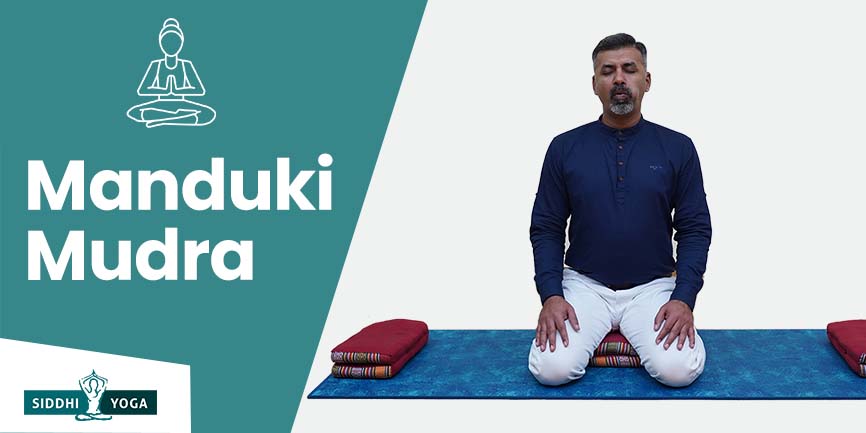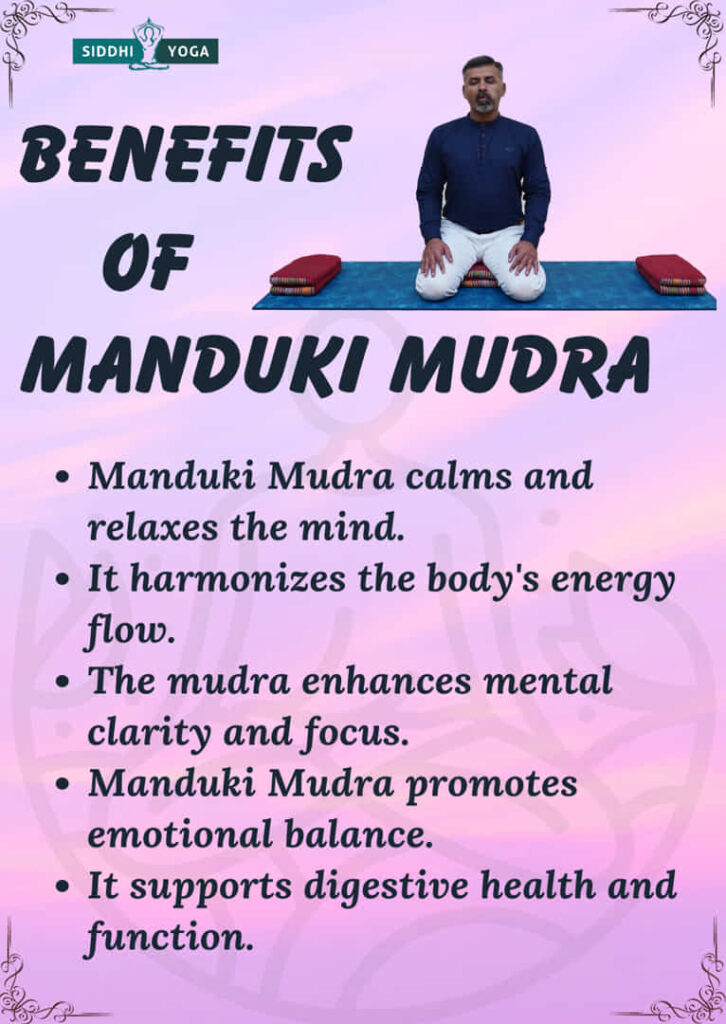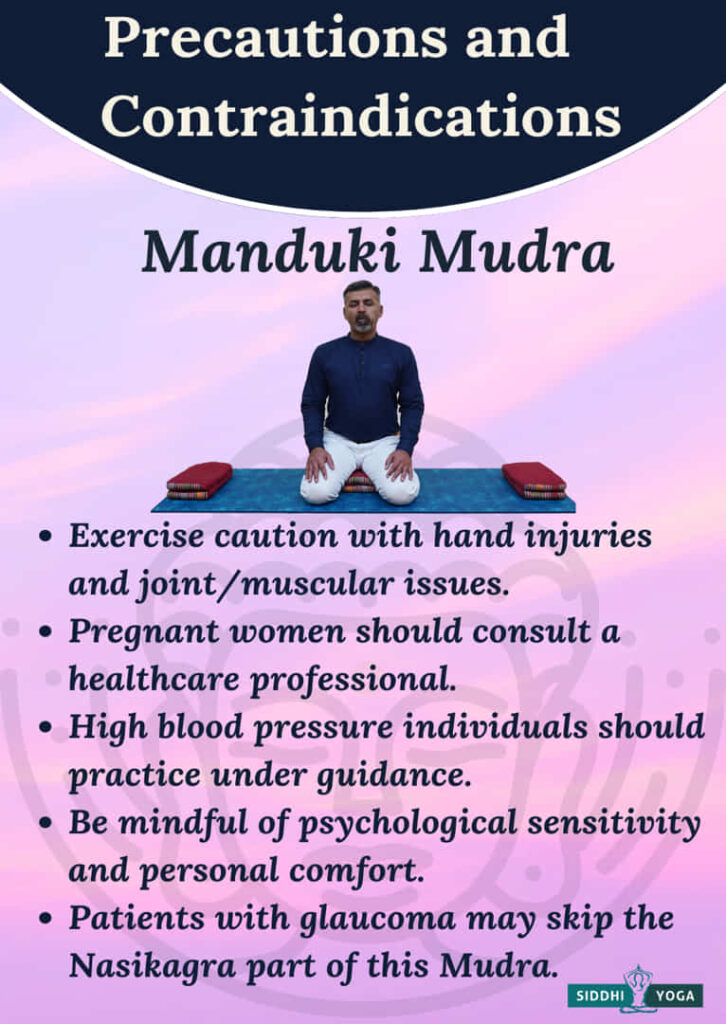
The Manduki mudra is a yogic gesture with many benefits. Discover what it is, how to do it, and the benefits you can get by practicing this, Mudra.
Definition – What is Manduki Mudra and its Meaning, References, and Mythology?
This is one of the Kaya Mudras. Let us simplify its meaning by breaking it down into two.
“Manduki” is used to represent “a frog.”
And “Mudra” represents a “Kaya gesture or seal.”
The Manduki Mudra mimics the posture of a frog at rest. Therefore, the name. It is also known as the “Gesture of the Frog” or “Frog Attitude.”
Manduki Mudra (postural gesture) is a Kaya yoga type that considers the whole body, from the tip of the toe to the top.
This Mudra requires that the lower body assume the Mandukasana position and the upper body rotate the tongue inside the closed mouth. It allows you to taste nectar flowing from your brain into every cell of your body.
Manduki Mudra is a very important yogic practice. It is mentioned in texts such as Gheranda Samhita. It is also used in sacred Upanishads to stimulate the facial organs.
Alternate Names of Manduki Mudra
The gesture of the Frog, Frog Attitude.
How to Do Manduki Mudra?
- This Mudra is one of the Kaya Mudras or Postural Mudras, which involves assuming bodily Postures.
- Manduki Mudra can be performed in a sitting position, but it is more comfortable to do so in a kneeling position such as Vajrasana and Bhadrasana.
- Hold the toes outwardly while you sit in Bhadrasana (gracious posture). Vajrasana is a better option if you are not comfortable in this position.
- Place a blanket or cushion under your buttocks to make sitting easier. Keep your buttocks in contact with the ground, so the perineum feels gentle pressure. This stimulates the Muladhara Chakra.
- Place your hands on your knees, keeping your head straight.
- Close your eyes and relax your whole body.
- Focused breathing is used to shift awareness to the tongue tip. Gradually rotate the tongue to the right and left sides of your mouth. The tongue is then rolled towards the mouth palate.
- The Manduki Mudra technique in Kundalini Kriyas involves holding the Nasikagra Drishti at Bhadrasana. This Mudra is eighth in the Kundalini Kriyas Kriya yoga, also known as Manduki Kriya.
- Close your mouth and move the tip towards the palate. Slowly, taste the nectar (the liquid that flows from the thousand-petalled lotus). This is called frog Mudra.
- If your eyes feel tired, close them for a few seconds to relax.
- Keep this practice going for five minutes until your mind and senses become more inward.
Manduki Mudra Benefits

- It relaxes the mind, and Manduki Mudra helps to calm the mind. This Mudra also helps to increase insight.
- Yogis believe Manduki Mudra stimulates Bindu’s nectar, which delays aging and prevents graying. The nectar flowing from the top of your head prevents greying. Rotating the tongue in the mouth helps to tone the facial muscles and keep wrinkles at bay.
- It aids digestion, and Manduki Mudra increases saliva secretion. It increases appetite and aids in digestion.
- It enhances the sense of taste. This practice also increases the taste buds by allowing the nectar to be tasted. This practice also promotes the strength and endurance of the tongue.
- Strengthening the throat muscles, Manduki Mudra is also well-known for its soothing effects on your throat. It rejuvenates the throat and has long-lasting benefits.
- The Frog gesture works by applying mild pressure to the perineum. This stimulates the Muladhara chakra, which has energetic benefits. It encourages growth and vitality.
- Strengthening leg muscles, the Frog gesture is also a yoga asana that increases the strength of the hips and knees. These muscles are stretched and made flexible.
Manduki Mudra Precautions and Contraindications

- Patients with glaucoma may skip the Nasikagra part of this Mudra.
- Do not use it if diabetic retinopathy is a problem.
- If you have had an eye operation, Manduki Mudra is not recommended.
- Make sure your hips, knees, and ankles can move enough to allow you to perform this gesture.
- You can also sit in Vajrasana if Bhadrasana does not feel comfortable.
- You can ease the position by placing a folded blanket under your buttocks. This will stimulate the Muladhara Chakra.
When and how long to do Manduki Mudra?
- Manduki Mudra should be practiced to bring a sense of calmness into life.
- It can also be practiced to strengthen the neck and throat muscles.
- It stretches important leg muscles, so practicing this will help you to keep these muscles mobile.
The practice should be completed for no more than 5 minutes. It is best to limit it to two minutes at a time, especially when you are just starting. Pay attention to the breathing pattern. It must be slow and deep. Focus on your nose tip, then slowly shift your focus to the Muladhara chakra. This Mudra must be done in a specific sequence.
Breathing in Manduki Mudra
Initially, you can practice this Mudra with:
- Deep, slow, and even breathing.
Affirmation in Manduki Mudra
“I have a love for animals, and I believe in co-existing.”
Conclusion
Regular practice of the Manduki Mudra can provide you with various benefits. These benefits include improved circulation, increased concentration and memory retention, detoxification of the body, relief from constipation and bloating, and more. If you’re interested in learning more about mudras and how to use them for your health and well-being, check out our Mudras Certification Course. This course provides comprehensive instruction on all 108 mudras, including their benefits, performance instructions, cautions, variations, and contraindications.